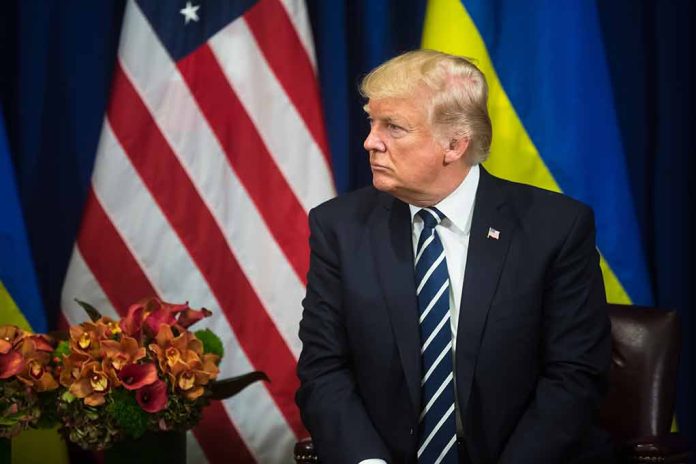
The Trump administration has reversed course on Ukraine policy, resuming military aid and intelligence sharing after Kyiv agreed to a 30-day ceasefire proposal that could potentially end three years of war with Russia.
Key Takeaways
- The Trump administration has lifted its suspension of military and intelligence aid to Ukraine after Ukraine expressed willingness to enter a 30-day ceasefire with Russia.
- Secretary of State Marco Rubio stated that Ukraine is ready to “stop shooting and start talking,” putting the responsibility for peace on Russia’s response.
- The U.S. will present the ceasefire proposal to the Kremlin, while European leaders are working to develop security guarantees for Ukraine.
- Russia has not offered concessions and continues to demand Ukraine drop its NATO bid and recognize Russian-occupied regions.
- Public sentiment in Ukraine remains cautious about the ceasefire, with concerns it may simply allow Russia to regroup militarily.
U.S. Policy Reversal Signals Strategic Shift
The resumption of military assistance and intelligence sharing marks a significant shift in the Trump administration’s approach to the Russia-Ukraine conflict. This decision came after high-level discussions in Saudi Arabia where Ukrainian officials expressed openness to a temporary ceasefire. National Security Advisor Mike Waltz emphasized the alignment between Kyiv and Washington, noting that Ukraine shares President Trump’s vision for peace. The renewed support demonstrates America’s commitment to Ukraine’s defense capabilities while simultaneously pursuing diplomatic channels to end the conflict that has destabilized Eastern Europe for three years.
Secretary of State Marco Rubio made clear that the next steps depend entirely on Moscow’s willingness to engage with the proposal. “We’re going to tell them this is what’s on the table. Ukraine is ready to stop shooting and start talking. And now it’ll be up to them to say yes or no. If they say no, then we’ll unfortunately know what the impediment is to peace here,” said Rubio during the announcement of the policy shift. This places diplomatic pressure on Russia while reinforcing Ukraine’s position as willing to negotiate despite ongoing battlefield challenges.
“The intelligence block is lifted. Arms can now resume.”
President Trump has lifted the pause on arms shipments and US intelligence sharing with Ukraine, says @JPonpolitics.
🔴https://t.co/ElNHhIYcEN#TimesRadio pic.twitter.com/qYRkfNWZW5
— Times Radio (@TimesRadio) March 11, 2025
Ukraine’s Position and Battlefield Realities
Ukrainian President Volodymyr Zelensky has publicly welcomed the ceasefire proposal while placing responsibility for next steps on Russia. “Ukraine welcomes this proposal, we consider it positive, we are ready to take such a step. The United States of America has to convince Russia to do this,” declared Zelensky. The Ukrainian leader’s cautious optimism reflects the complex battlefield situation, where Russia currently maintains momentum, particularly in the eastern Donetsk region. Ukraine has developed its domestic arms industry, notably high-tech drones, to supplement international aid in its defensive efforts against Russian advances.
Military activities continue despite diplomatic overtures. Ukraine recently launched a massive drone attack targeting several Russian regions, including Moscow, while Russia responded with counterattacks using drones and a ballistic missile. These ongoing hostilities underscore the urgency of the ceasefire proposal while highlighting public concerns in Ukraine that a temporary halt in fighting might simply allow Russian forces to regroup and reinforce their positions rather than lead to genuine peace negotiations.
International Coordination and Security Guarantees
European allies have mobilized to support the ceasefire initiative with concrete measures to ensure Ukraine’s security. French President Emmanuel Macron has called for developing a comprehensive plan to define security guarantees for Ukraine should a ceasefire take effect. Working alongside British Prime Minister Keir Starmer, Macron is leading efforts to form an international coalition capable of enforcing ceasefire conditions. This European involvement demonstrates the transatlantic commitment to finding a sustainable resolution to the conflict while addressing Ukraine’s legitimate security concerns.
A recent meeting in Paris brought together representatives from 34 countries to discuss establishing credible security guarantees linked to NATO capabilities. Prime Minister Starmer praised the US-Ukraine agreement as a significant breakthrough and urged Russia to agree to the ceasefire terms. Meanwhile, President Trump has indicated he might speak directly with Russian President Vladimir Putin and has welcomed President Zelensky back to the White House, signaling a multi-pronged diplomatic approach involving both direct engagement with Moscow and strengthened ties with Kyiv.
Russia’s Response and Path Forward
Russia has yet to formally respond to the ceasefire proposal but has maintained consistent demands throughout the conflict. The Kremlin continues to insist that Ukraine abandon its NATO membership aspirations and recognize Russian sovereignty over occupied territories, including Crimea and parts of eastern Ukraine. These positions have been major obstacles to previous peace efforts and represent significant challenges to the current initiative. Secretary Rubio’s statement clarifies that Russia’s response to the ceasefire proposal will reveal its genuine commitment to ending the conflict.
As the Trump administration pursues this two-track approach of military support and diplomatic engagement, the path forward depends on Moscow’s willingness to negotiate in good faith. Ukrainian officials continue to emphasize their goal of achieving a “just and lasting peace” with meaningful security guarantees rather than temporary solutions that fail to address fundamental sovereignty issues. The resumption of U.S. military aid provides Ukraine with enhanced leverage in potential negotiations while demonstrating America’s commitment to preventing a unilateral Russian victory that would redraw European borders by force.
Sources:
U.S. will immediately resume military aid as Ukraine says it is open to 30-day ceasefire
Ukraine backs 30-day ceasefire as US ends aid freeze







